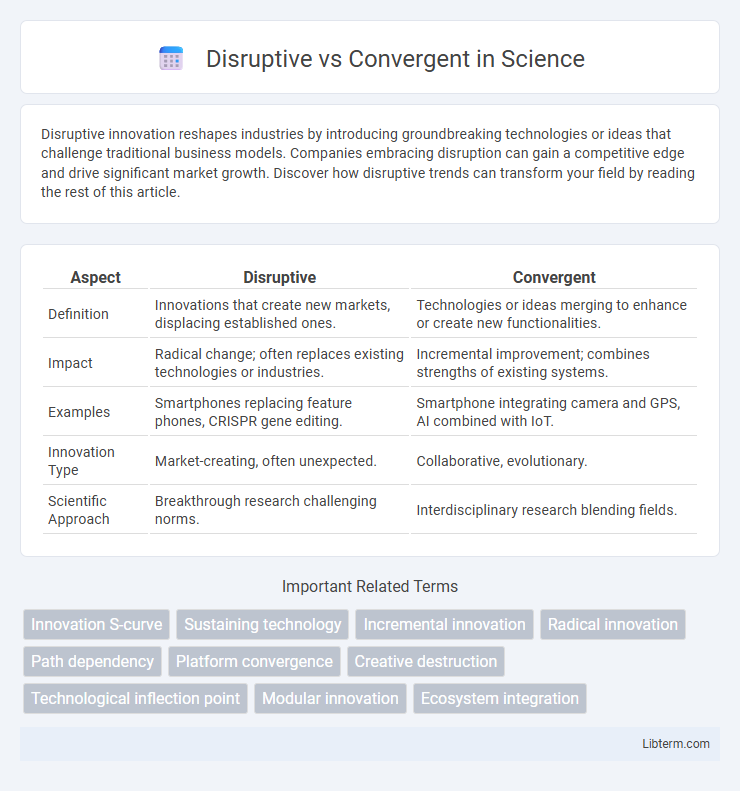Disruptive innovation reshapes industries by introducing groundbreaking technologies or ideas that challenge traditional business models. Companies embracing disruption can gain a competitive edge and drive significant market growth. Discover how disruptive trends can transform your field by reading the rest of this article.
Table of Comparison
| Aspect | Disruptive | Convergent |
|---|---|---|
| Definition | Innovations that create new markets, displacing established ones. | Technologies or ideas merging to enhance or create new functionalities. |
| Impact | Radical change; often replaces existing technologies or industries. | Incremental improvement; combines strengths of existing systems. |
| Examples | Smartphones replacing feature phones, CRISPR gene editing. | Smartphone integrating camera and GPS, AI combined with IoT. |
| Innovation Type | Market-creating, often unexpected. | Collaborative, evolutionary. |
| Scientific Approach | Breakthrough research challenging norms. | Interdisciplinary research blending fields. |
Defining Disruptive Innovation
Disruptive innovation refers to technologies or business models that fundamentally change or create new markets by displacing established products or services with more accessible, affordable, or convenient alternatives. Unlike convergent innovation, which blends existing technologies to enhance features or performance within established markets, disruptive innovation often targets overlooked segments or creates entirely new value networks. This process reshapes industry landscapes by challenging dominant players and shifting consumer expectations.
Understanding Convergent Innovation
Convergent innovation integrates multiple existing technologies or ideas to create novel solutions that address complex challenges across industries, driving efficiency and enhancing user experience. By combining diverse fields such as AI, IoT, and biotechnology, convergent innovation fosters collaborative ecosystems, enabling rapid adaptation and scalability in dynamic markets. This approach contrasts disruptive innovation, which typically breaks markets with entirely new paradigms, as convergent innovation builds on and evolves current technologies for incremental yet impactful advancements.
Key Differences Between Disruptive and Convergent Approaches
Disruptive approaches fundamentally alter existing markets by introducing innovations that create new value networks and displace established technologies or products, while convergent approaches integrate and unify multiple technologies or systems to enhance performance and create synergistic solutions. Disruptive innovation often targets underserved or new markets with simpler, more affordable products, whereas convergent innovation combines existing capabilities to address complex challenges or improve user experiences. Key differences lie in their impact scope, with disruptive focusing on market transformation and convergence emphasizing technological integration and collaboration.
Historical Examples of Disruptive Innovation
Disruptive innovation historically transformed industries by introducing groundbreaking technologies that fundamentally altered market dynamics, such as the introduction of the personal computer disrupting mainframe computing in the 1970s and 1980s. The emergence of digital photography in the late 1990s supplanted traditional film cameras, revolutionizing image capture and storage. These innovations created new markets while rendering existing products and business models obsolete, distinguishing disruptive innovation from convergent innovation that typically integrates existing technologies to improve efficiency.
Notable Cases of Convergent Innovation
Convergent innovation integrates existing technologies to create novel solutions, exemplified by notable cases such as the smartphone, which combines computing, telephony, and internet connectivity. Another key example is the development of smart home systems that merge IoT, automation, and AI to enhance user convenience and energy efficiency. These innovations demonstrate how convergent technologies generate new market opportunities by blending multiple disciplines into unified products.
Drivers Behind Disruptive and Convergent Trends
Disruptive trends are driven primarily by groundbreaking innovations that challenge existing market norms and create entirely new value propositions, often fueled by emerging technologies and shifts in consumer behavior. Convergent trends arise from the integration of previously distinct technologies, industries, or services, driven by the demand for seamless user experiences and efficiencies in operations. Both trends are propelled by evolving digital capabilities, regulatory changes, and global connectivity that reshape industries and competitive landscapes.
Business Impacts: Disruptive vs. Convergent Strategies
Disruptive strategies drive radical market shifts by introducing innovative products or services that render existing solutions obsolete, often capturing new customer segments and creating competitive advantages. Convergent strategies integrate complementary technologies or business models to enhance value propositions, streamline operations, and foster collaborative ecosystems. Businesses leveraging disruptive approaches may face higher risks but can gain significant market share, whereas convergent strategies emphasize sustainable growth and incremental innovation within established markets.
Market Adoption: Speed and Scalability
Disruptive innovations often face slower initial market adoption due to the need to alter consumer behavior and integrate new technologies, but they enable rapid scalability once entrenched. Convergent innovations leverage existing market frameworks and technologies, allowing faster adoption but may encounter limitations in scalability due to incremental improvements. The strategic choice between disruptive and convergent approaches directly impacts how quickly products gain traction and the potential scale of market penetration.
Future Outlook: Collaboration or Collision?
Disruptive technologies challenge existing market leaders by creating entirely new value networks, while convergent technologies blend multiple innovations to enhance existing systems, shaping the future of industries. The future outlook suggests a complex interplay where collaboration between disruptive startups and convergent incumbents accelerates innovation, driving transformative growth and resilience. Strategic partnerships and adaptive ecosystems will determine whether this dynamic results in synergistic advancement or competitive collision.
Choosing the Right Approach for Your Organization
Disruptive innovation drives radical change by introducing groundbreaking technologies or business models that redefine markets, whereas convergent innovation integrates existing ideas and technologies to create incremental improvements. Organizations must evaluate their industry dynamics, risk tolerance, and long-term goals to determine whether a disruptive strategy will capture new markets or a convergent approach will enhance current competitive advantages. Aligning innovation strategy with organizational capacity and market demands ensures sustainable growth and maximizes return on investment.
Disruptive Infographic

 libterm.com
libterm.com